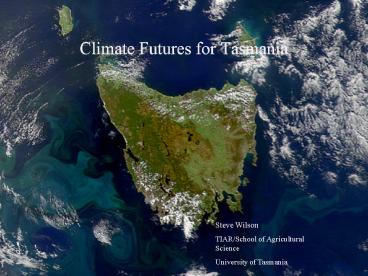Climate Futures for Tasmania - PowerPoint PPT Presentation
1 / 19
Title:
Climate Futures for Tasmania
Description:
Climate Futures for Tasmania Steve Wilson TIAR/School of Agricultural Science University of Tasmania * * * * * * The world in 2040: Predicted higher carbon dioxide ... – PowerPoint PPT presentation
Number of Views:100
Avg rating:3.0/5.0
Title: Climate Futures for Tasmania
1
Climate Futures for Tasmania
Steve Wilson TIAR/School of Agricultural
Science University of Tasmania
2
- The world in 2040
- Predicted
- higher carbon dioxide
- higher average temperature
- higher average rainfall
- higher average humidity
- Unknown
- local climate and weather
- physical and economic impacts
- opportunities
3
GCM Temperature Prediction to 2070
4
Australia in 2030 Rainfall decrease 2-5 in the
south mainly in winter and spring. No change in
the north. Evapotranspiration increase Australia
wide of 2 Drought various measures but
projected to increase frequency and intensity
Temperature overall 0.9oC, greater inland less
on coast. Increased frequency of extreme
temperature days Wind generally increased wind
flow, but projected decrease in summer at 40oS
Drivers El Nino to become drier, SAM positive
shift causing weaker westerly wind flows
5
Devil in the detail? Queensland Fruit fly
winter soil temperature threshold for pupal
survival is unknown (9.7oC for Med-fly) Wine
grapes wine quality and summer temperatures
6
Increasing soil temperatures
Real data for a forgotten environment?
7
The range for Queensland fruitfly air
temperature? rainfall? soil temperature?
From Meats (2004)
8
Wine quality decrease in traditional areas?
more suitable land in Tasmania
9
Background
- Previous study for Hydro Tasmania, results
published 2005 - One model extended to 2040 with a focus on
catchment inflow data
10
- Tasmania in 2040
- Predicted
- Rainfall
- no change to slight decrease in annual total
- increase in winter and early spring
- Temperature
- insignificant to small increase in mean daily
maxima - small increase in mean daily minima
- significant (1oC) increase in winter-early summer
minima - Wind and evaporation
- small increases in both wind speed and potential
evaporation - Unknown
- frost frequency and intensity
- frequency, duration and distribution of extended
rain events
11
This Project
- ACE CRC in collaboration with others
- 3 year project, building on the work undertaken
for Hydro Tasmania - Delivering results applicable to range of
Tasmanian stakeholders - Producing results on a range of possible futures,
out to 2100
12
Structure
- Fine-scale (10-15 km resolution) climate
projections for Tasmania under a range of
accepted greenhouse gas emission scenarios. Model
outputs will be tailored for specific
applications - Water - catchments and reservoirs
- Extreme events
- Climate impacts on agriculture and other
industries
13
Outputs
- Assessments of the range of climate conditions
likely to be experienced across Tasmania over the
next 90 years (to 2100) - Reports on future projections for key variables
identified as important by end users - Climate model outputs provided for input into
operational models by collaborating end-users - Raw model results for all estimated variables
will be stored and available on-line for further
research or application.
14
Water
- Sample information runoff and catchment yields,
evaporation rates - Research providers Hydro Tasmania, DPIW, ACE CRC
- Primary End Users Hydro Tasmania, water
authorities, local government, agriculture,
forestry
15
Extreme Events
- Sample information fire weather, storm surges,
high intensity rainfall events, extreme wind
events - Research providers SES, CSIRO, BOM, ACE CRC
- Primary End Users SES, Local Government, Aurora,
Transend, Fire Service
16
General Climate Impacts
- Sample data seasonal and spatial rainfall
distribution, seasonal maximum, minimum and
average air and soil temperatures, evaporation
and wind flow. - Research providers TIAR, DPIW, CSIRO, BOM, ACE
CRC - Primary End Users Agriculture, Forestry, Local
Government, Hydro, Aurora, Transend, SES, DPIW
17
Outcomes
- Industries, government utility and services
agencies and communities informed about likely
climate conditions in coming decades - A database for planning adaptation strategies
- Advanced warning of key vulnerabilities to
climate change for risk mitigation - Identification and awareness of industry
opportunities and the capacity to plan to take
maximum advantage of likely changes in climate.
18
Timing
- Primary analysis
- All new climate prediction model runs complete by
end 2009 - Secondary analysis
- Preliminary analysis/modelling within the three
components using output from the existing Hydro
Tasmania model in 2008 - Incorporation of new model outputs into secondary
models and vulnerability/opportunity analyses in
years 2 and 3
19
TIAR activities
- Links with other agencies and organisations
- Links with community - extension and information
flow - Outputs available for all current research and
development programs - Climate change as a research priority area -
impacts, adaptation and opportunities - Funding for new research programs
- Beyond 2010?































